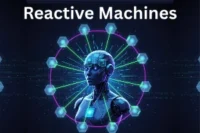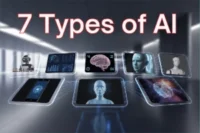Future of AI in Education: Transforming Learning for Students
Published: 26 Sep 2025
The future of AI in education is about making schools smart and making it easier to learn. Today, some schools are already utilizing AI to review homework, provide instant feedback, and aid students in understanding lessons. But have you thought about which classes can be held later? Will the robots teach, or will the teacher and AI work together? Currently, many teachers have a heavy workload, and students often require additional support.
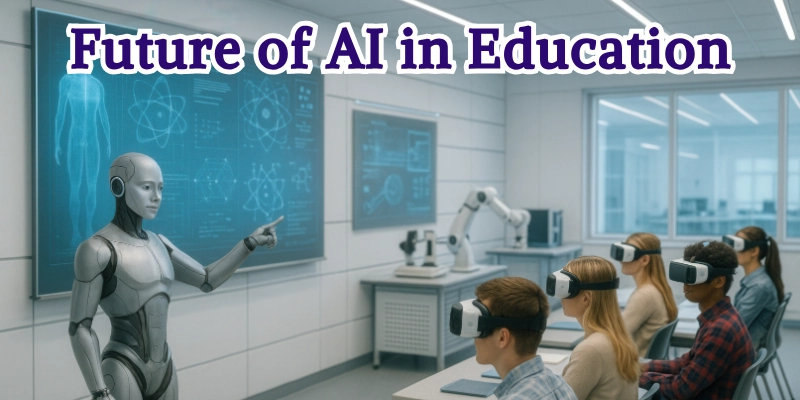
AI can save time, respond quickly, and help each child learn in their own way. Imagine a class where the lessons change so that you fit yourself and your questions get immediate answers. This is the one who can bring AI into education.
How AI is Helping in Education Today
AI is already making school work easier for teachers and students. Here are some simple ways it helps:
- Smart tutoring apps assist students with their homework and explain lessons in a step-by-step manner.
- Language-learning apps like Duolingo make learning a new language fun and simple.
- Automatic grading tools quickly check tests or assignments, allowing teachers to save time.
- Chatbots answer common student questions right away, even after school hours.
Key Benefits of AI in Education
AI helps both students and teachers in many ways. Below are the main benefits explained in simple words:
| Advantage of AI in Education |
|---|
Here are the advantages of AI in education
|
Future Possibilities of AI in Education
AI will continue to change how students learn and how teachers teach. Over the coming years, it may create new ideas that make the school easier and more fun for everyone. The future of AI in education includes exciting new tools and ideas that can help students learn even better. Here are some exciting ways that can help in future education.
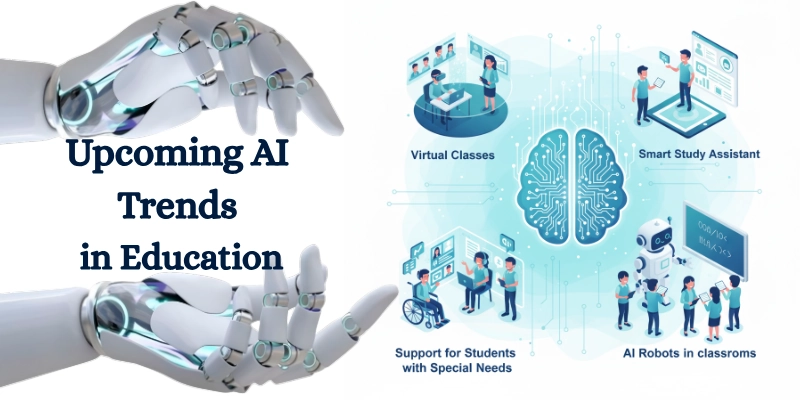
- Virtual classes
- Smart Study Assistant
- Support for Students with Special Needs
- AI Robots in Classrooms
Without wasting time, let’s get into the article and discuss the future of AI in education one by one.
Virtual classes
AI can create online classes where students can join from anywhere in the world. This means that learning is not limited to the school building.
- Students from different countries can study at the same time.
- Teachers can provide lessons to many students at a time.
- Children who cannot travel can still participate in the class.
- Recorded lessons can be seen at any time.
- Students can ask live questions during the class.
- AI tools can translate lessons into many languages.
- Parents can also see a lesson to help children.
Smart Study Assistant
AI can act as a personal assistant to plan and manage study time. It guides the students on what to learn first and when to take a break.
- Reminds students about homework and projects.
- Suggestions on which subjects require more practice.
- Creates a study program for the exam.
- Time suggests how to handle well.
- The track shows the area’s progress and improvement.
- Alerts send a notice when the deadline is approaching.
- Encourages students to take healthy breaks.
Support for Students with Special Needs
AI can help children with disabilities learn more easily by giving them tools and lessons made for their needs.
- Speech-to-text helps children who cannot write.
- Text-to-speech reads lessons aloud for individuals who have difficulty seeing.
- AI can adjust the size of text or images.
- Personalized games help children learn at their own speed.
- AI can translate sign language into spoken words.
- Gives real-time feedback to teachers about student progress.
- Helps parents track their child’s learning at home.
AI Robots in Classrooms
Robots with AI can join classrooms to guide group work or explain lessons in simple words.
- Robots can answer students’ basic questions.
- They can show science experiments safely.
- Help shy students feel more comfortable speaking.
- Include fun quizzes and games to make lessons more engaging.
- Assist teachers in large classrooms.
- Can repeat instructions as many times as needed.
- Teach in different languages if required.
Challenges of AI in Education
AI is useful in education, but there are some problems we should notice and solve.
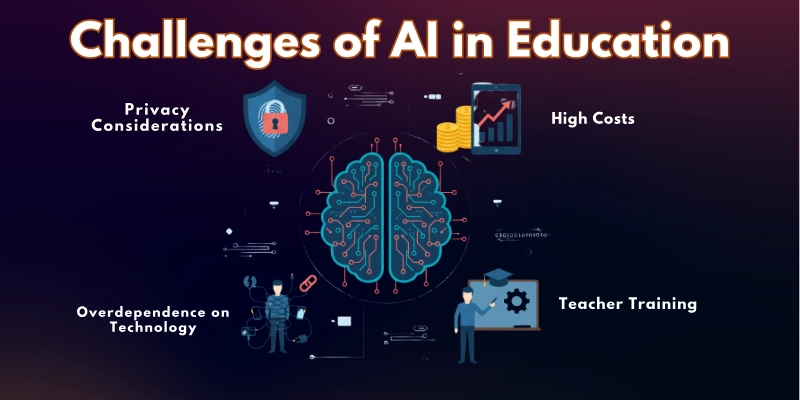
A. Privacy consideration
It is important to keep the student’s information safe.
- Protect the student data from hackers.
- Use strong passwords and privacy settings.
- Check the apps that collect personal information.
B. High Costs
AI equipment can be very expensive for many schools.
- AI equipment and software are expensive.
- The training teacher adds extra cost.
- Small schools cannot update.
C. Overdependence on Technology
Excessive use of AI can make students very dependent on it.
- Students can forget basic skills.
- Creativity and problems can fall.
- Excessive screen time can damage health.
D. Teacher Training
Teachers require proper training to use AI correctly.
- Teachers need a lesson to use AI well.
- Without training, equipment can be abused.
- Regular workshops help teachers to be ready.
Tips for Using AI Safely in Schools
Here are some simple ways to keep AI use safe and helpful in classrooms.
- Keep software updated to avoid security problems.
- Teachers should double-check AI answers before sharing them.
- Parents and teachers should guide students on healthy screen time.
- Use only trusted apps and websites for learning.
- Teach students not to share personal information online.
Real-Life Examples
Here are some simple ways AI is already used in schools today.
- AI chatbots help students by answering homework questions.
- Smart grading systems check tests and assignments in many universities.
- Apps like Duolingo teach new languages using AI to make learning fun.
- Reading apps use AI to help children improve pronunciation.
- AI tools help teachers plan lessons and find extra study materials.
Conclusion
So guys, in this article, we’ve covered the future of AI in education in detail. AI can make learning easier, faster, and more fun for students while helping teachers save time and focus on teaching. I personally recommend using AI as a helper, not a replacement for teachers. It works best when combined with real teaching and guidance.
With the right balance, AI can open doors to new skills and a brighter future in education. Keep exploring these tools and use them wisely to make learning better every day.
FAQs: Future of AI in Education
After reading about the future of AI in education, you might have some questions. Here are common ones with simple answers:
AI in education uses smart computer programs to help students learn better and make teachers’ work easier. It can give personal lessons, grade homework, or answer questions. AI supports teachers but does not replace the care and guidance they provide.
AI can adjust lessons to match each student’s speed. If a student finds a topic easy, it move on faster; if a topic is hard, it gives extra practice. This helps children understand lessons better and learn at their own pace.
No. AI can assist with homework, grading, or planning lessons, but it cannot replace a teacher’s guidance. Teachers provide understanding, motivation, and emotional support that AI cannot offer. AI works best as a helper alongside teachers
AI is safe when schools and parents protect personal data and use trusted apps. Children should not share private information online, and parents should monitor screen time. Following simple rules helps students learn safely with AI.
Yes. Many AI programs and apps can be used on computers, tablets, or phones at home. Students can practice lessons or review topics anytime, even after school. This makes learning more flexible and convenient.
AI can read lessons aloud, convert speech to text, or adjust content for students with disabilities. It makes learning easier and more enjoyable for children with different abilities. Teachers and parents can also track progress using AI tools.
Some AI tools and software can be expensive, especially for small schools. However, there are free or low-cost apps that still help students learn effectively. Schools can choose the best options based on their budget and needs.
Yes. AI might give wrong answers or suggestions sometimes. Teachers should always review AI results and guide students when corrections are needed.
It can happen if students use AI for every task. Overreliance may reduce creativity and problem-solving skills. Parents and teachers should encourage children to practice thinking and learning without AI sometimes.
AI will continue improving lessons, helping teachers, and supporting students anywhere. It can make learning more personal, fun, and accessible for all children. With proper guidance, AI can open doors to better skills and brighter opportunities.

- Be Respectful
- Stay Relevant
- Stay Positive
- True Feedback
- Encourage Discussion
- Avoid Spamming
- No Fake News
- Don't Copy-Paste
- No Personal Attacks

- Be Respectful
- Stay Relevant
- Stay Positive
- True Feedback
- Encourage Discussion
- Avoid Spamming
- No Fake News
- Don't Copy-Paste
- No Personal Attacks


